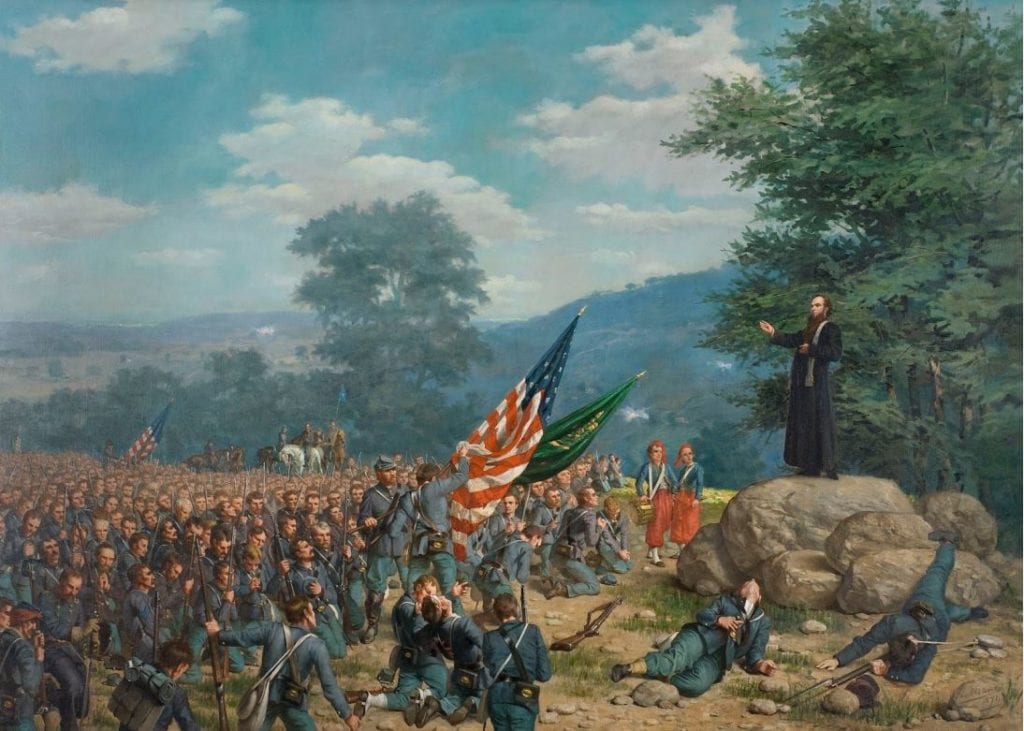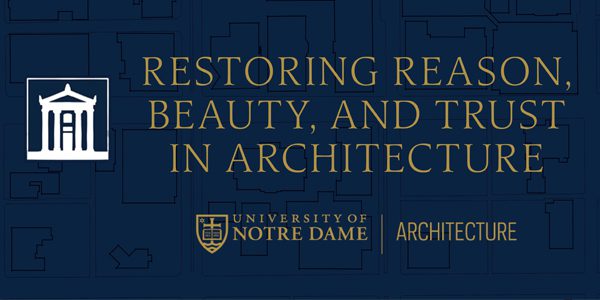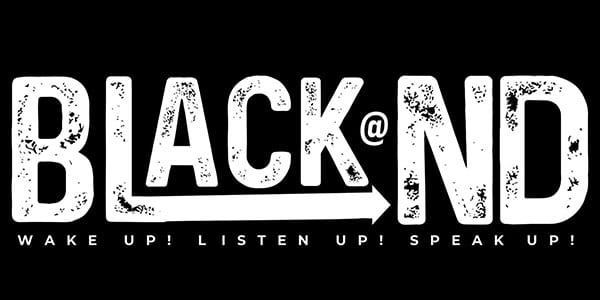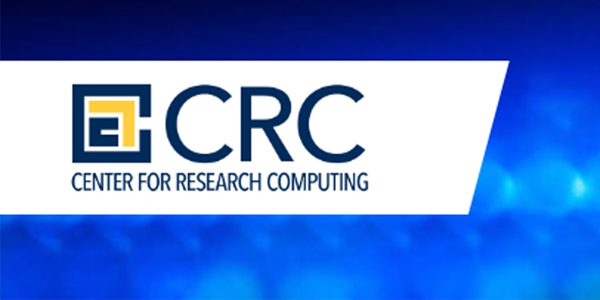Absolution Under Fire

Click on the image to have a closer look at the painting.
Rev. William J. Corby, C.S.C., at the Battle of Gettysburg
In his painting Absolution Under Fire, Paul Henry Wood commemorated a singular and historic event that occurred on July 2, 1863, during the three-day Civil War battle at Gettysburg, Pennsylvania. Barely nineteen when he completed his painting in the autumn of 1891, Wood captured the dramatic moment before the fighting started when Rev. William J. Corby, C.S.C., then chaplain of the 88th New York Regiment, one of five regiments in the legendary Irish Brigade, stood upon a boulder and addressed the troops. Exposing himself to enemy fire, with cannonballs exploding nearby and bullets whistling overhead, Corby exhorted the soldiers to remember the noble cause and sacred nature of their duty. He then urged them to make a sincere act of contrition before receiving conditional absolution (forgiveness of sin en masse) from him.
Almost as one, the men dropped to their knees, heads bowed in prayer. According to eyewitness Colonel St. Clair Mulholland of the 116th Pennsylvania Regiment, the scene was “one of the most impressive religious ceremonies I have ever witnessed.” Mulholland explained that,
“The Irish Brigade . . . was now commanded by Colonel Patrick Kelly, of the Eighty-eighth New York, and formed a part of this division. The brigade stood in columns of regiments closed in mass. As the large majority of its members were Catholics, the Chaplain of the Brigade, Rev. William Corby, C.S.C., proposed to give a general absolution to all the men before going into the fight. While this is customary in the armies of Catholic countries of Europe, it was perhaps the first time it was ever witnessed on this continent . . . [As Corby] closed his address, every man, Catholic and non-Catholic, fell on his knees with his head bowed down. Then, stretching his right hand toward the brigade, Father Corby pronounced the words of the absolution . . . The scene was more than impressive; it was awe-inspiring.”
In his Memoirs of Chaplain Life: Three Years with the Irish Brigade in the Army of the Potomac, Corby relayed his intention and his impression of the event:
“In performing this ceremony I faced the army. My eye covered thousands of Officers and men. I noticed that all, Catholic and non-Catholic officers and private soldiers showed a profound respect, wishing at this fatal crisis to receive every benefit of divine grace that could be imparted through the instrumentality of the Church ministry . . . That general absolution was intended for all—in quantum possum—not only for our brigade, but for all, North or South, who were susceptible of it and who were about to appear before their Judge . . . The battle lasted three days and was the greatest of the war.”
The Battle of Gettysburg was the bloodiest battle of the Civil War, with casualties exceeding 57,000. Fr. Corby’s absolution of the troops had a profound effect on the survivors for years to come.
Army Chaplains and Notre Dame’s Military in the Civil War
Gardiner H. Shattuck, Jr., states that, “during the four years of the Civil War, a total of approximately 2,500 men served as chaplains in the Union army… Chaplains in the Civil War era not only were almost exclusively Christian, but they were also overwhelmingly Protestant: just one rabbi and approximately forty Roman Catholic priests are known to have served in the Union army.” In the Confederate forces, only a handful of Roman Catholic priests served as chaplains.
In both armies, chaplains often occupied an awkward position: without clear instructions as to their responsibilities, many never knew what was expected of them in the field. Though some remained unsure of their role as religious figures in a military setting, many chaplains took the opportunity to define both practical and spiritual tasks as they saw fit. Many performed essential 2
services for their regiments; they conducted worship services, prayed with, and counseled soldiers, cared for the sick and wounded, buried the dead, guarded prisoners, delivered mail, and chronicled their regiments’ activities, among other duties. Such care promoted better morale throughout the ranks, allowing the Union and Confederate armies to carry on the fight.
Chaplains argued that the spiritual authority they exercised not only enabled soldiers to grow and maintain their faith, but also enhanced the fighting spirit of their units. Father Corby’s actions at Gettysburg—and indeed, throughout his three years serving as army chaplain—illustrate that bond between religious devotion and combat morale. That Corby exposed himself to enemy fire while tending to soldiers’ spiritual needs, at a crucial and tense moment on the Gettysburg battlefield, as he did in many other instances, further solidified the loyalty and esteem he enjoyed with his regiment. Other chaplains who similarly demonstrated bravery and compassion toward the troops in their care earned the respect of the soldiers they served.
Many Holy Cross priests, brothers, and sisters served as chaplains and nurses in the Civil War. Rev. Edward Sorin, president of the university, worked hard to ensure that Holy Cross clerics weren’t conscripted into actual fighting and gained support for that stance from Generals William Tecumseh Sherman and Ulysses S. Grant. Not only did bearing arms conflict with the vocation of the religious; Notre Dame could ill afford to lose so many clerics and still function as a university. While the Notre Dame company did not serve as a whole unit, many individual students and alumni took up arms—most for the Union, but some for the Confederacy.
Not incidentally, the nickname “Fighting Irish” was first coined for the Irish immigrant soldiers who fought for the Union in what became the Irish Brigade.
The Irish Brigade in Cultural Context
Seven Holy Cross priests from the University volunteered to serve as Union Army chaplains during the Civil War. Among them was Father Corby, who ministered to the five infantry regiments comprised mostly of Irish Catholic immigrants primarily recruited from New York City, Boston, and Philadelphia. They were the 63rd, 69th, and 88th New York Infantries, the 28th Massachusetts Infantry, and the 116th Pennsylvania Infantry; together, they were known as the Irish Brigade.
The Irish Brigade fought in every major battle of the eastern theater of the war, from Bull Run to Appomattox. Severely decimated at Antietam and Fredericksburg, nearly half of the 530 who arrived at Gettysburg would be wounded, killed, or missing by the end of the battle. And, by the end of the war, 4,000 had died, more than in any other brigade. Their courage in battle won them the admiration of North and South alike.
Yet whether Irish immigrants in the North would fight for the Union was still an open question in the months leading up to the Civil War. Irish Catholic immigrants had not been warmly welcomed in the U.S.; beginning in the 1830s, a considerable number of native-born Protestant 3
Americans regarded the Irish as a threat. By the 1850s, the Nativists, or Know-Nothings, were a well-organized political movement intent on inflaming suspicions that Catholics’ foreign allegiance to the Pope threatened the republic. Anti-Irish, anti-Catholic bigotry was not limited to politics; in some cities and town, Nativist mobs destroyed Catholic churches and burned homes of American Catholics.
It was due to the efforts of three Irishmen—Archbishop John Hughes of New York, Colonel Michael Corcoran, commander of the all-Irish militia regiment, the 69th New York; and Captain Thomas Francis Meagher—that Irish immigrants were persuaded to join the Union Army. In 1861, Meagher published a broadside calling for Irish recruits in which he promised soldiers would serve with fellow Irishmen, under Corcoran and Meagher, with a Catholic chaplain assigned to their brigade. The chaplain assigned to them was a 28-year-old Holy Cross Father, William Corby. Thousands turned out and from those men, Meagher selected 3,000 to form the Irish Brigade.
As historian Thomas J. Craughwell has stated: ‘In spite of the bigotry and violence of the Nativists, the Irish recognized that America promised freedom unknown in Europe and opportunities unimaginable in Ireland—and the men of the Irish Brigade were willing to fight to defend those opportunities and preserve that freedom.’
University President Corby and His Legacy
After the war, William Corby (1833-1897) returned to Notre Dame. Rev. Patrick Dillon, brother of Corby’s fellow Irish Brigade chaplain, was elevated to the presidency in 1865. Fr. Corby was made vice president of the university and, after Father Dillon’s untimely death the next year, was installed as the university’s third president. Most notably, Corby established the law school and founded Notre Dame Scholastic, the official chronicle of university events.
In 1872, Corby left the presidency to help establish Sacred Heart College in Watertown, Wisconsin. He returned in 1877 to serve a second term as university president. It was during this second term that, on April 23, 1879, a fire almost completely destroyed the college. Corby immediately organized a successful rebuilding effort that allowed the college to reopen that fall. With the University rebuilt and enrollment increasing, Corby left the presidency to return as pastor of St. Bernard’s parish in Watertown. In 1886, he left that post to become Provincial General of the Congregation of Holy Cross for the United States, religious responsibilities that later expanded to include global duties as Assistant General for the Congregation of Holy Cross.
Fr. Corby embarked on a new era in his life in 1888 when he joined other Irish Brigade veterans in a reunion celebrating the twenty-fifth anniversary of the Battle of Gettysburg. More than fifty thousand veterans gathered at Gettysburg that summer, an event that touched Corby deeply. In his last years, many of Corby’s activities revolved around his war-time service, the most significant of which was his writing Memoirs of Chaplain Life. Working almost entirely from memory, Corby produced a very human account of life in a Civil War army, as seen through the eyes of a chaplain.
The positive response to his Memoirs showed Corby how useful his wartime experiences were in encouraging patriotic pride within American Catholics and in defending them against their detractors. To the end of his life, he continued to highlight the important role thousands of patriotic Catholics had rendered in the Civil War.
Fr. Corby died on December 28, 1897, after falling ill with a cold that developed into pneumonia. The Notre Dame community celebrated his life with impressive ceremonies in the Church of the Sacred Heart but, in a fitting departure from custom, his casket, wrapped in the flag of his old regiment, was borne to the grave by aging Civil War veterans.
Commemoration Ceremony 150 years later
Besides Paul Henry Wood’s depiction of Corby’s famous absolution, that act has been immortalized in two sculptures of Father Corby: a life-size bronze erected in 1910 at Gettysburg on the very boulder upon which he stood; and a smaller bronze replica now on the Notre Dame campus. The statue commemorates the moment on July 2, 1863, when Father Corby gave the general absolution moments before the Confederate assault on the Union troops defending Cemetery Ridge.
Corby’s influence continues to be acknowledged at the university and beyond. On June 22, 2013, Rev. John I. Jenkins, C.S.C., current president of the university, commemorated the 150th anniversary of the Battle of Gettysburg at the Gettysburg National Military Park by presiding over a special mass. He reflected on Corby’s actions and the moral principles and religious faith undergirding them:
“Fr. Corby’s sacramental invocation of God’s mercy for all was a reflection of his faith in God who is Father of all, loves all, has mercy on all. And this statue is a reminder to us not only of this momentous battle of a distant war, but of the call on us to embrace the same faith: to recognize the deeper bonds that unite us no matter how dire the conflicts that divide us.”
The Artist
Paul Henry Wood is the accomplished young painter who captured the historic event at Gettysburg in Absolution Under Fire. Born in Elgin, Illinois in 1872, Wood displayed an unusual facility for drawing. From an early age, his pencil drawings were generally battle scenes, his inclination toward drawing military life perhaps stimulated by the panorama craze of the day. His family moved to Chicago in 1883 where his artistic talent was noticed by his teachers at St. James’ Parochial School. Realizing that Paul Henry Wood needed more advanced instruction than they could provide, his teachers introduced Paul to Sister Pius, the director of the Art Department at St. Xavier’s Academy. Sister Pius gladly agreed to instruct Paul and did so for the next two years until she concluded that Paul needed more advanced instruction. She was able to gain him an audience with the renowned Italian painter Luigi Gregori who was then artist-in-residence and Director of the Art Department at the University of Notre Dame.
Luigi Gregori had been brought to campus in 1874 by Fr. Edward Sorin, founder and first president of Notre Dame. Gregori was the artist who designed and painted the Christopher Columbus murals in the Main Building as well as the murals and stations of the cross in the Basilica of the Sacred Heart. After examining Paul Wood’s work and watching him sketch from life, Gregori declared that, “never have I seen in Europe or America a child with such extraordinary talent.” In late May 1887, at age fourteen, Paul entered Notre Dame to study with Signor Gregori at his studio. For the next few years, Paul progressed from drawing to the use of oils while Gregori had him work on portraits and religious scenes.
In September 1890, Paul was delighted to be offered a commission to paint Father Corby giving absolution to the soldiers at the Battle of Gettysburg. The subject was an ideal fit for Paul; he wrote in his diary that this was “just the kind of work which I love to paint: scenes of blood, carnage, death, sudden and fearful, . . . fire, smoke, and battle . . .”. Within a few weeks, he had completed the painting.
With Professor Gregori about to return to Italy, arrangements were made for Paul to accompany him. The news of their imminent departure and the success of his painting of Fr. Corby at Gettysburg led to commissions pouring in from American art patrons for Paul to copy famous European art works. With that financial support, Paul planned to finance his studies with Gregori in Florence.
Wood spent the 1891 Christmas holidays with his family in their fifth-floor Chicago apartment, sharing with them his exciting plans for the future. But the gifted young artist’s professional career ended before it had begun, for early in the morning of January 4, 1892, a long-smoldering fire erupted in the building’s ground-floor restaurant, creating tremendous smoke and panic. Paul was in an overloaded elevator with his family when the gearing gave way and the car fell. Paul Wood was crushed to death, the only fatality.
The Notre Dame campus went into mourning as the students returned from Christmas break. Fr. Corby himself traveled to Chicago to sing a Solemn Requiem High Mass at Paul Henry Wood’s funeral.
Sources
Corby, C.S.C., William. Memoirs of Chaplain Life: Three Years with the Irish Brigade in the Army of the Potomac. Edited by Lawrence Frederick Kohl. First published 1893; New York: Fordham University Press, 1992.
Craughwell, Thomas J. “Remembering Ireland and Fighting for the Union: The Irish Brigade during the Civil War.” The American Spectator, vol. 44, no. 6 , July–August 2011, p.26+.
Deeben, John P. “Faith on the Firing Line: Army Chaplains in the Civil War.” in Genealogy Notes, Prologue Magazine, National Archives, vol. 48, no. 1, Spring 2016. www.archives.gov/publications/prologue/2016/spring/chaplains.html
Gardiner H. Shattuck, Jr., “Faith, Morale, and the Army Chaplain in the American Civil War,” Chapter 5 in The Sword of the Lord: Military Chaplains from the First to the Twenty-first Century. Edited by Doris L. Bergen. Notre Dame, IN: University of Notre Dame Press, 2004.
Jenkins, C.S.C., Rev. John I. “Selected Writings and Addresses by Rev. John I. Jenkins, C.S.C.: Battle of Gettysburg 150 Anniversary Address.” president.nd.edu/writings-addresses/2013-addresses/battle-of-gettysburg-150th-anniversary-ad dress/ and news.nd.edu/news/gettysburg/
Notre Dame Scholastic. vol. XIII, no. 30, April 3, 1880, pp.470-471. [Mulholland’s account was originally published in the Philadelphia Times, and reprinted in Notre Dame Scholastic]
Notre Dame Scholastic. vol. XXV, no. 30, April 2, 1892, pp.503-505.
O’Shaughnessy, Brendan. “What’s in a Name? How Notre Dame became the Fighting Irish.” Office of Public Affairs and Communications, University of Notre Dame. www.nd.edu/features/whats-in-a-name/
“Rev. William Corby at Gettysburg,” University of Notre Dame Archives. July 2, 2013, www.archives.nd.edu/about/news/index.php/2013/corby-gettysburg/
“The Military at Notre Dame,” University of Notre Dame Archives. November 11, 2010, www.archives.nd.edu/about/news/index.php/2010/the-military-at-notre-dame/
May 29, 2020



